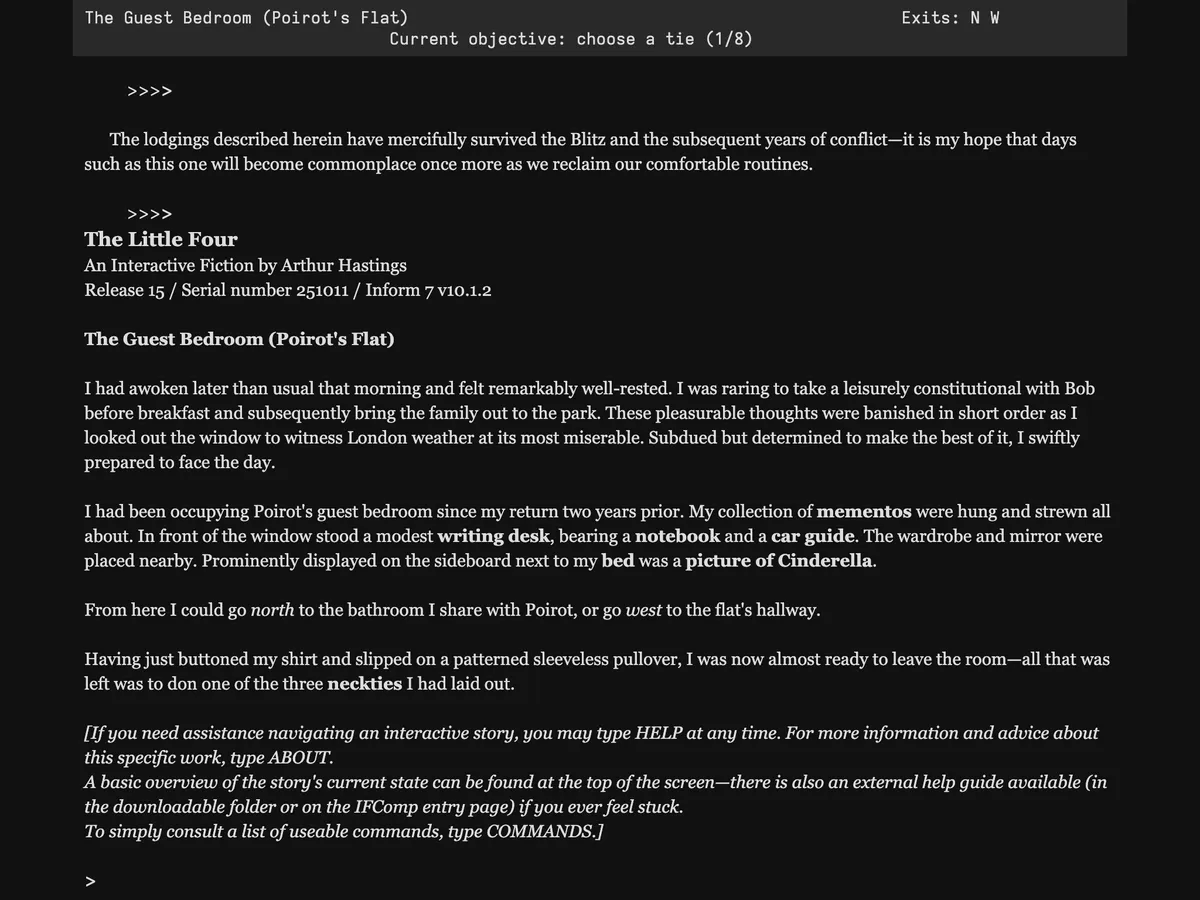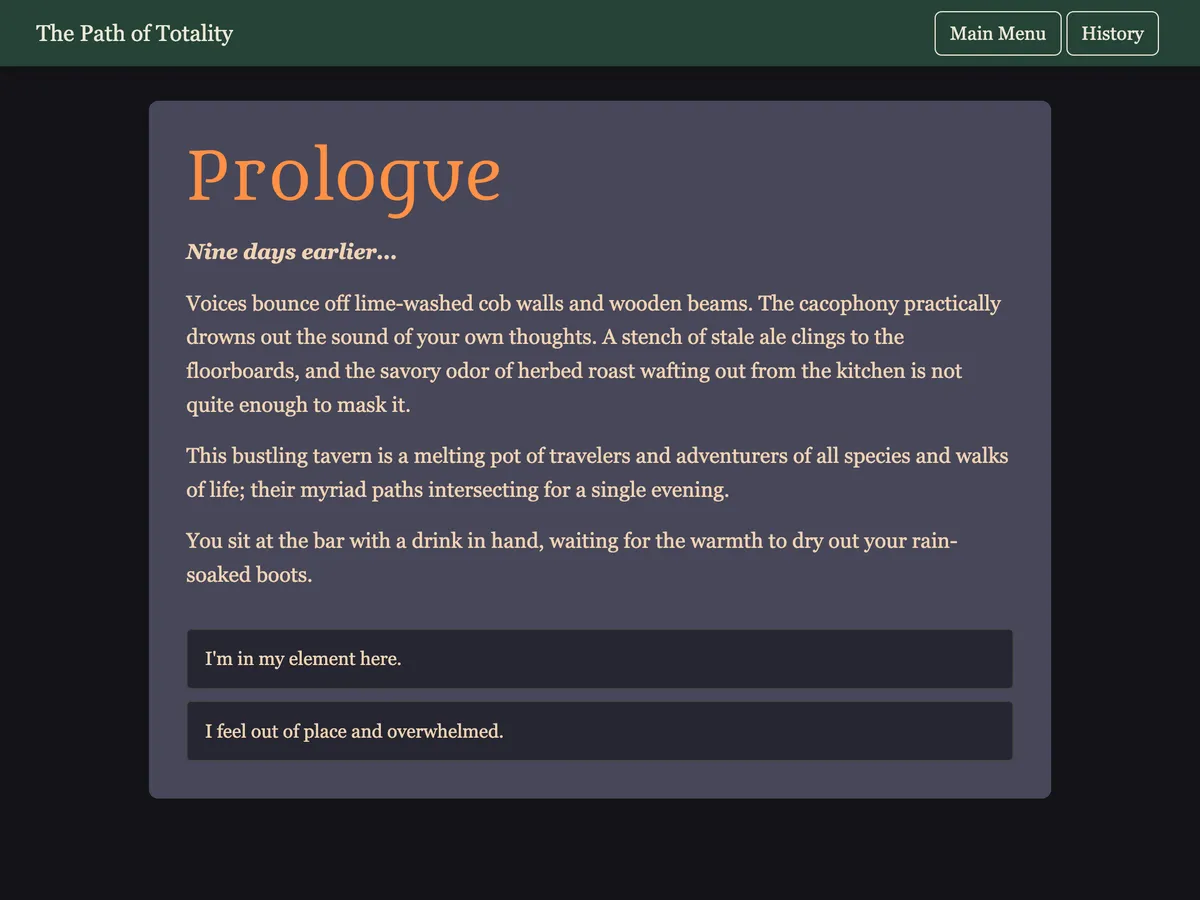A spotter's guide to text games
So I don't namesearch on Bluesky, but having just released a game (KINOPHOBIA, which you can play right now) I have been occasionally searching its name just to see what people are saying about it without mentioning me.
And one thing that jumped out at me – and please don't think this is a callout of this specific person – was someone referring to it as a "twine game." Which is it not! But of course, Twines are a huge proportion of text games and have been for a long time now, so it's natural that people might genericize the term to mean any text game.
But, if you say "twine game" generically meaning "text game", you're liable to confuse people who expect that it means a very specific kind of text game. So, here's a little guide on how to tell apart the major types of text games you're likely to find in the wild.
This is not a comprehensive set because I'm just including the most common things that are presented as pure-text games and broadly as "interactive fiction"; which is to say, things someone might call "a Twine game" casually in that way. So I'm not going to talk about things like the Reigns swipe-right/left interface, or games like Lovely Lady RPG and other Narrat games. I'm also not going to talk about "parserless parser" games (what IFDB calls "parser-choice hybrids") because there's simply so few of them.
Parser Games

Pictured: The Little Four.
These are the oldest, most traditional, and most insular genre of text games, going back the origins of the adventure-game genre in the 1980s. The term "text adventure" is in fact a retronym for these games; they of course came first, so they used to just be "adventure games", by analogy with the original Adventure.
Nowadays, the terms "parser game" or "parser interactive fiction" are generally-accepted general terms; "text adventure" tends to imply specifically an old-school sensibility that you wouldn't apply to KINOPHOBIA or to something like Chandler Grover's Eat Me. Even old Infocom games like Plundered Hearts (1987) somewhat resist the "text adventure" label.
The defining feature of parser games is of course the parser – the software component that interprets written commands from the player into in-game actions. Parser games, then, have the unique UI affordance of typing a command, getting a response, typing a new command, etc.
The other half of parser games is the idea of a "world model"; the commands that you type are not individually-defined options that the author has created, but rather actions in a simplified but fairly sophisticated simulated world. So you can TAKE some object and then carry it with you and DROP it arbitrarily anywhere on the map, and so on.
Hypertext games

Pictured: The Witch Girls.
The biggest and broadest category of text games; not all hypertext games are made with Twine (a specific tool), but the overwhelming majority are.
Hypertext games generally present the story as a series of discrete "pages" or "screens" connected by links, with the distinction that those links can be anywhere. The inline link embedded within the text is in many ways the defining literary device of the Twine scene. Also common is the use of links that change the text on a given page without moving you to an entirely different page, which is itself a whole family of affordances and aesthetic devices.
Choice-based games

Pictured: The Path of Totality.
Choice games may present story as discrete 'screens' or 'scenes', or as one continuous spool of text; they periodically interrupt their text to ask the player to make a choice – once made, the choice then progresses the game.
This is a format that's very widely adopted in commercial interactive fiction or text-heavy games; visual novels are definitely a cousin to this style of game, too. Inkle exemplifies this relationship; older Inkle games like 80 Days are very classically "choice-based interactive fiction", whereas newer games like Expelled! are presented in a way that more closely resembles a visual novel... but they are constructed in structurally very similar ways. The prototypical choice-game is really a Choice of Games title.
Choice and hypertext are very closely related, but I do think it's worth raising the distinction. Do you interact with links that are placed in a freeform way throughout the text? Hypertext. Do you interact with choices that are always consistently positioned relative to the text? Choice.
This may seem like an incidental distinction but it also points to radically different authoring systems and aesthetic traditions. People have used Twine to make games with a 'choice' style of presentation, but a common feature of more specialized choice systems – link Ink – is that they treat story more fluidly than Twine does; rather than Twine's discrete nodes (that present as individual 'screens' or 'scenes' to the player), Ink stories are continuously assembled by tracing a 'path' through the text, in which boundaries are fluid and text is often generated/stitched together/altered on the fly.
Again – this is a very basic survey for folks new to the genre; there are many variants, hybrids, experiments, and unfoldings of these basic forms. The point here is emphatically not to impose some pedantic correction on people, it's just to help give people more descriptive language to talk about interactive fiction in the interest of getting more people to play interactive fiction.